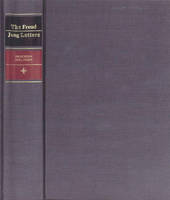
|
The Freud/Jung Letters: The Correspondence between Sigmund Freud and C. G. Jung
Hardback
Main Details
| Title |
The Freud/Jung Letters: The Correspondence between Sigmund Freud and C. G. Jung
|
| Authors and Contributors |
By (author) Sigmund Freud
|
|
By (author) C. G. Jung
|
|
Edited by William McGuire
|
| Series | Bollingen Series |
|---|
| Physical Properties |
| Format:Hardback | | Pages:732 | | Dimensions(mm): Height 229,Width 152 |
|
| ISBN/Barcode |
9780691098906
|
| Classifications | Dewey:150.195 |
|---|
| Audience | | Professional & Vocational | | Tertiary Education (US: College) | |
|---|
|
Publishing Details |
| Publisher |
Princeton University Press
|
| Imprint |
Princeton University Press
|
| Publication Date |
21 April 1974 |
| Publication Country |
United States
|
Description
In April 1906, Sigmund Freud wrote a brief note to C. G. Jung, initiating a correspondence that was to record the rise and fall of the close relationship between the founder of psychoanalysis and his chosen heir. This correspondence is now available for the first time, complete except for a few missing letters apparently lost long ago. The letters, some 360 in number, span seven years and range in length from a postcard to a virtual essay of 1,500 words. In accordance with an agreement between the writers' sons, Ernst Freud and Franz Jung, the letters are published as documents, without interpretation, but with a detailed annotation that identifies more than 400 persons, 500 publications, and many literary and topical allusions. Anna Freud comments, "[The annotation] has turned the correspondence truly into a history of the beginnings of psychoanalysis, something that was very much needed and is not given anywhere else with the same attention to detail and inclusion of all the people in public life who cither came to psychoanalysis for a while or turned violently against it from the beginning...Every detail is necessary and enhances the value of the book." There are appendixes, facsimiles, and contemporary photographs. The index, with bibliographical details, is exhaustive. As historical documents, the letters reflect the early struggles of Freud and Jung in gaining acceptance for psychoanalysis. Freud, Jung's senior by twenty years, patiently assesses the opposition, cautioning the fiery Jung to concentrate more on his research than on answering the critics. The two exchange candid opinions on their colleagues, plan strategies for the advancement of their cause, and most important, share their experiences with patients and with the reading that led them to new scientific realizations. The correspondence provides an account of the composition of many papers, lectures, and books of Freud, Jung, and their colleagues, and describes the genesis of the journals, conferences, and international and local societies of the movement. The decline of the correspondence documents Jung's increasing reluctance to accept the entire Freudian code, and the growing bitterness that led to the mutual decision to end the correspondence and the relationship.
Reviews"The relationship between Sigmund Freud and C. G. Jung had its bright beginning in 1906 and came to its embittered end in 1913. It disatrous course was charted by the many letters the two men wrote each other... As [the book] bears upon the personal lives of the men between whom the letters passed and upon the intellectual history of our epoch, it is a document of inestimable importance."--Lionel Trilling, The New York Times Book Review "Both as it bears upon the personal lives of the men between whom the letters passed and upon the intellectual history of our epoch, it is a document of inestimable importance."--The New York Times Book Review
|